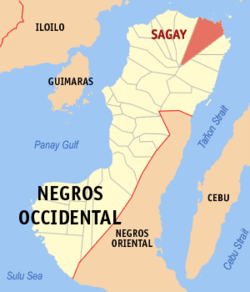Sagay
| Sagay | ||
|---|---|---|
| Component City | ||
| City of Sagay | ||
|
||
 Map of Negros Occidental with Sagay highlighted |
||
| Location within the Philippines | ||
| Coordinates: 10°54′N 123°25′E / 10.900°N 123.417°ECoordinates: 10°54′N 123°25′E / 10.900°N 123.417°E | ||
| Country | Philippines | |
| Region | Negros Island Region (NIR/Region XVIII) | |
| Province | Negros Occidental | |
| Congr. district | 2nd district of Negros Occidental | |
| Established | 1860 | |
| Cityhood | August 10, 1996 | |
| Barangays | 25 | |
| Government | ||
| • Mayor | Alfredo D. Marañon III | |
| Area | ||
| • City | 330.34 km2 (127.54 sq mi) | |
| Population (2010) | ||
| • City | 140,740 | |
| • Density | 430/km2 (1,100/sq mi) | |
| Time zone | PST (UTC+8) | |
| ZIP code | 6122 | |
| Dialing code | 34 | |
| Languages | Hiligaynon, Cebuano, Tagalog, English | |
Sagay, officially Sagay City, is a third class city in the province of Negros Occidental, Philippines. According to the 2010 census, it has a population of 140,740 people.
Sagay can be easily identified in the map of Negros Occidental, because of its "ice-cream cone" shape sliced from the northern tip of Negros. It is bounded in the north by Asuncion Pass and the Visayan Sea; the City of Talisay and Municipality of Calatrava in the south; cities of Cadiz and Silay in the west and the City of Escalante and Municipality of Toboso in the east.
The name of the city comes from the semi-spherical shell called "sigay", which can be found in the area.
Sagay City is politically subdivided into 25 Barangay.
Sagay City was originally called Arguelles Nicolai when Teniente Francisco Rodriguez and Basilio Cordova founded it in 1860 in the mouth of the Bulanon River. Later, by the order of the Spanish governor the town was transferred to Pueblo de Magallanes (now known as Old Sagay) in honor of Fernando Magallanes.
Having the status of a pueblo, Sagay was entitled to have a "Capitan del Pueblo," the highest town official during the time. The first to be appointed to this position by the Spanish Governor was Elulalio Rodriguez. Gregorio Parreño, and Peter Parker later succeeded him.
During the Philippine Revolution, Sagay contributed its share to what proved to be a successful national struggle for independence. The hard-won First Philippine Republic was however short-lived when the country passed to the hands of another colonial power, the United States of America in 1898.
In 1906, during the administration of the second President Benjie Adolfo, the name of the town was officially changed to Sagay. The name was taken from the semi-spherical shell called "sigay", which can be found in the area. The American influence seeped into every aspect of Sagay's life, politically and culturally. At this period of Sagay's history, land transportation began to supplant sea travel, but the seaside community continued to flourish. The first public schools conducted in English were established. Mr. Cornelio Pascual, Sr. was the first English Teacher assigned in Vito. American missionaries were sent to tutor more Filipino English teachers.
...
Wikipedia


